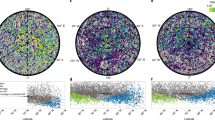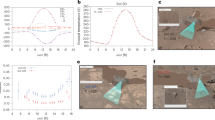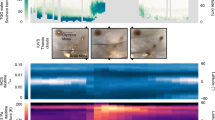Abstract
Water ice is thought to be trapped in large permanently shadowed regions in the Moon’s polar regions, due to their extremely low temperatures. Here, we show that many unmapped cold traps exist on small spatial scales, substantially augmenting the areas where ice may accumulate. Using theoretical models and data from the Lunar Reconnaissance Orbiter, we estimate the contribution of shadows on scales from 1 km to 1 cm, the smallest distance over which we find cold-trapping to be effective for water ice. Approximately 10–20% of the permanent cold-trap area for water is found to be contained in these micro cold traps, which are the most numerous cold traps on the Moon. Consideration of all spatial scales therefore substantially increases the number of cold traps over previous estimates, for a total area of ~40,000 km2, about 60% of which is in the south. A majority of cold traps for water ice is found at latitudes > 80° because permanent shadows equatorward of 80° are typically too warm to support ice accumulation. Our results suggest that water trapped at the lunar poles may be more widely distributed and accessible as a resource for future missions than previously thought.
This is a preview of subscription content, access via your institution
Access options
Access Nature and 54 other Nature Portfolio journals
Get Nature+, our best-value online-access subscription
$29.99 / 30 days
cancel any time
Subscribe to this journal
Receive 12 digital issues and online access to articles
$119.00 per year
only $9.92 per issue
Buy this article
- Purchase on Springer Link
- Instant access to full article PDF
Prices may be subject to local taxes which are calculated during checkout




Similar content being viewed by others
Data availability
All data used in this study are publicly available. The Diviner and LROC data can be accessed through the NASA Planetary Data System: https://pds-geosciences.wustl.edu. The higher-level data products generated in this study are available from the authors and on GitHub: https://github.com/phayne.
Code availability
All code generated by this study is available from the authors and/or on GitHub: https://github.com/phayne/heat1d and https://github.com/nschorgh/Planetary-Code-Collection/blob/master/Topo3D.
References
Urey, H. C. The Planets, Their Origin and Development (Yale Univ. Press, 1952).
Watson, K., Murray, B. C. & Brown, H. On the possible presence of ice on the Moon. J. Geophys. Res. 66, 1598–1600 (1961).
Vasavada, A. R., Paige, D. A. & Wood, S. E. Near-surface temperatures on Mercury and the Moon and the stability of polar ice deposits. Icarus 141, 179–193 (1999).
Harmon, J. K. & Slade, M. A. Radar mapping of Mercury: full-disk images and polar anomalies. Science 258, 640–643 (1992).
Harmon, J. K., Slade, M. A. & Rice, M. S. Radar imagery of Mercury’s putative polar ice: 1999–2005 Arecibo results. Icarus 211, 37–50 (2011).
Platz, T. et al. Surface water-ice deposits in Ceres’s northern permanent shadows. Nat. Astron. 1, 0007 (2017).
Neumann, G. A. et al. Bright and dark polar deposits on Mercury: evidence for surface volatiles. Science 339, 296–300 (2013).
Paige, D. A. et al. Thermal stability of volatiles in the north polar region of Mercury. Science 339, 300–303 (2013).
Ermakov, A. I. et al. Ceres’ obliquity history and its implications for permanently shadowed regions. Geophys. Res. Lett. 44, 2652–2661 (2017).
Margot, J. L., Campbell, D. B., Jurgens, R. F. & Slade, M. A. Topography of the lunar poles from radar interferometry: a survey of cold trap locations. Science 284, 1658–1660 (1999).
Feldman, W. C. et al. Global distribution of neutrons from Mars: results from Mars Odyssey. Science 297, 75–78 (2002).
Colaprete, A. et al. Detection of water in the LCROSS ejecta plume. Science 330, 463–468 (2010).
Watson, K., Murray, B. C. & Brown, H. The behavior of volatiles on the lunar surface. J. Geophys. Res. 66, 3033–3045 (1961).
Arnold, J. R. Ice in the lunar polar regions. J. Geophys. Res. 84, 5659 (1979).
Chin, G. et al. Lunar Reconnaissance Orbiter overview: the instrument suite and mission. Space Sci. Rev. 129, 391–419 (2007).
Elvis, M., Milligan, T. & Krolikowski, A. The peaks of eternal light: a near-term property issue on the Moon. Space Policy 38, 30–38 (2016).
NASA The Artemis Accords https://www.nasa.gov/specials/artemis-accords/index.html (accessed 25 June 2020).
Paige, D. A. et al. Diviner Lunar Radiometer observations of cold traps in the Moon’s south polar region. Science 330, 479–482 (2010).
Mazarico, E., Neumann, G. A., Smith, D. E., Zuber, M. T. & Torrence, M. H. Illumination conditions of the lunar polar regions using LOLA topography. Icarus 211, 1066–1081 (2011).
Hayne, P. O. et al. Evidence for exposed water ice in the Moon’s south polar regions from Lunar Reconnaissance Orbiter ultraviolet albedo and temperature measurements. Icarus 255, 58–69 (2015).
Buhl, D., Welch, W. J. & Rea, D. G. Reradiation and thermal emission from illuminated craters on the lunar surface. J. Geophys. Res. 73, 5281–5295 (1968).
Bandfield, J. L., Hayne, P. O., Williams, J.-P., Greenhagen, B. T. & Paige, D. A. Lunar surface roughness derived from LRO Diviner Radiometer observations. Icarus 248, 357–372 (2015).
Rubanenko, L. & Aharonson, O. Stability of ice on the Moon with rough topography. Icarus 296, 99–109 (2017).
Robinson, M. et al. Lunar Reconnaissance Orbiter Camera (LROC) instrument overview. Space Sci. Rev. 150, 81–124 (2010).
Aharonson, O. & Schorghofer, N. Subsurface ice on Mars with rough topography. J. Geophys. Res. 111, E11007 (2006).
Hayne, P. O. & Aharonson, O. Thermal stability of ice on Ceres with rough topography. J. Geophys. Res. 120, 1567–1584 (2015).
Bussey, D. B. J. et al. Permanent shadow in simple craters near the lunar poles. Geophys. Res. Lett. 30, 1278 (2003).
Smith, B. G. Lunar surface roughness: shadowing and thermal emission. J. Geophys. Res. 72, 4059–4067 (1967).
Rosenburg, M. et al. Global surface slopes and roughness of the Moon from the Lunar Orbiter Laser Altimeter. J. Geophys. Res. 116, E02001 (2011).
Hayne, P. O. et al. Global regolith thermophysical properties of the moon from the Diviner lunar radiometer experiment. J. Geophys. Res. 122, 2371–2400 (2017).
Ingersoll, A. P., Svitek, T. & Murray, B. C. Stability of polar frosts in spherical bowl-shaped craters on the Moon, Mercury, and Mars. Icarus 100, 40–47 (1992).
Mahanti, P. et al. Inflight calibration of the Lunar Reconnaissance Orbiter Camera Wide Angle Camera. Space Sci. Rev. 200, 393–430 (2016).
Helfenstein, P. & Shepard, M. K. Submillimeter-scale topography of the lunar regolith. Icarus 141, 107–131 (1999).
Williams, J.-P. et al. Seasonal polar temperatures on the Moon. J. Geophys. Res. 124, 2505–2521 (2019).
Rubanenko, L., Venkatraman, J. & Paige, D. A. Thick ice deposits in shallow simple craters on the Moon and Mercury. Nat. Geosci. 12, 597–601 (2019).
Poston, M. J. et al. Temperature programmed desorption studies of water interactions with Apollo lunar samples 12001 and 72501. Icarus 255, 24–29 (2015).
Farrell, W. et al. The young age of the LAMP-observed frost in lunar polar cold traps. Geophys. Res. Lett. 46, 8680–8688 (2019).
Moores, J. E. Lunar water migration in the interval between large impacts: heterogeneous delivery to permanently shadowed regions, fractionation, and diffusive barriers. J. Geophys. Res. 121, 46–60 (2016).
Pike, R. J. in Impact and Explosion Cratering: Planetary and Terrestrial Implications Vol. 1 (eds Roddy, D. J. et al.) 489–509 (Pergamon, 1977).
Aharonson, O., Schorghofer, N. & Hayne, P. O. Size and solar incidence distribution of shadows on the Moon. In Proc. Lunar and Planetary Science Conference Vol. XLVIII, 2245 (Lunar and Planetary Institute, 2017).
Pike, R. J. Depth/diameter relations of fresh lunar craters: revision from spacecraft data. Geophys. Res. Lett. 1, 291–294 (1974).
Schörghofer, N. Planetary-Code-Collection: thermal and ice evolution models for planetary surfaces v1.1.4 https://github.com/nschorgh/Planetary-Code-Collection/ (2017).
Longuet-Higgins, M. S. Statistical properties of an isotropic random surface. Philos. Trans. R. Soc. A 250, 157 (1957).
Janna, W. S. Engineering Heat Transfer 2nd edn (CRC Press, 1999).
Acknowledgements
This study was supported by the Lunar Reconnaissance Orbiter project and NASA’s Solar System Exploration Research Virtual Institute. We thank E. Mazarico for valuable discussions and data on PSR area derived from LOLA elevation data and illumination models, and P. Mahanti for crater depth/diameter ratio data. We also thank P. G. Lucey for insightful criticism that improved this work. O.A. wishes to thank the Helen Kimmel Center for Planetary Science, the Minerva Center for Life Under Extreme Planetary Conditions and the I-CORE Program of the PBC and ISF (centre no. 1829/12). N.S. was in part supported by the NASA Solar System Exploration Research Virtual Institute Cooperative Agreement (NNH16ZDA001N) (TREX).
Author information
Authors and Affiliations
Contributions
P.O.H. initiated the study, developed the approach and general methodology, analysed the Diviner data and performed the model fitting. O.A. compiled the shadow fractions from images, computed the lateral heat conduction limitation and helped to construct the overall description of cold-trap scale dependence. N.S. derived the equations for shadows in a bowl-shaped crater and carried out the numerical energy balance calculations. All authors contributed to the writing of the manuscript.
Corresponding author
Ethics declarations
Competing interests
The authors declare no competing interests.
Additional information
Peer review information Nature Astronomy thanks Timothy McClanahan and the other, anonymous, reviewer(s) for their contribution to the peer review of this work.
Publisher’s note Springer Nature remains neutral with regard to jurisdictional claims in published maps and institutional affiliations.
Supplementary information
Supplementary Information
Supplementary Figs. 1–10.
Rights and permissions
About this article
Cite this article
Hayne, P.O., Aharonson, O. & Schörghofer, N. Micro cold traps on the Moon. Nat Astron 5, 169–175 (2021). https://doi.org/10.1038/s41550-020-1198-9
Received:
Accepted:
Published:
Issue Date:
DOI: https://doi.org/10.1038/s41550-020-1198-9
This article is cited by
-
Future Directions for the Investigation of Surface-Bounded Exospheres in the Inner Solar System
Space Science Reviews (2023)
-
Illumination and regolith temperature at China’s next candidate lunar landing site Shackleton crater
Science China Earth Sciences (2023)
-
Statistical Thermodynamics of Surface-Bounded Exospheres
Earth, Moon, and Planets (2022)
-
The Exosphere as a Boundary: Origin and Evolution of Airless Bodies in the Inner Solar System and Beyond Including Planets with Silicate Atmospheres
Space Science Reviews (2022)
-
Will increasing traffic to the Moon contaminate its precious ice?
Nature (2021)



